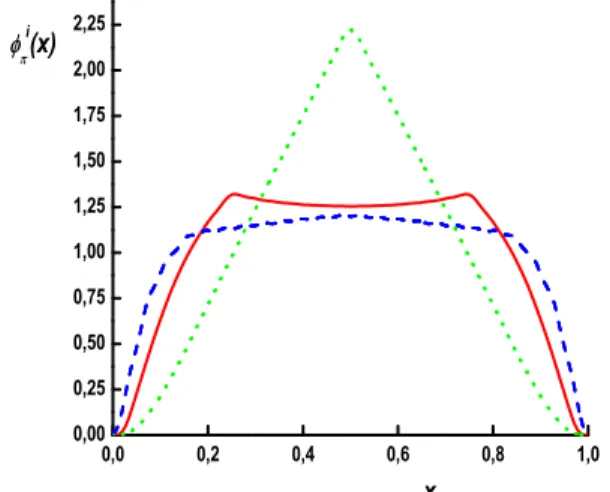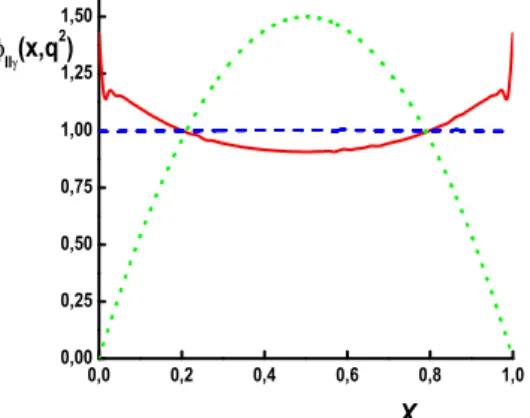Brazilian Journal of Physics, vol. 37, no. 2C, June, 2007 819
Distribution Amplitudes of Light Mesons and the Photon in the Instanton Model
Alexander E. Dorokhov
Bogoliubov Laboratory of Theoretical Physics, Joint Institute for Nuclear Research, 141980 Dubna, Russia
Received on 30 October, 2006; revised version received on 17 February, 2007
The leading- and higher-twist distribution amplitudes of the pion, theρ-meson and real and virtual photons are analyzed in the instanton liquid model.
Keywords: QCD; Instanton; High energy; Quark; Pion; Photon; Distribution amplitude
I. INTRODUCTION
The investigations of hard exclusive processes are essen-tial for our understanding of the internal quark-gluon dynam-ics of hadrons. Theoretically, such studies are based on the assumption of factorization of dynamics at long and short distances. The short-distance physics is well elaborated by perturbative methods of QCD and depends in particular on the hard subprocesses. The long-distance dynamics is essen-tially nonperturbative and within the factorization formalism becomes parametrized in terms of hadronicdistribution am-plitudes(DAs). These nonperturbative quantities are univer-sal and are defined as vacuum-to-hadron matrix elements of particular nonlocal light-cone quark or quark-gluon operators. The evolution of DAs at sufficiently large virtualityq2is con-trolled by the renormalization scale dependence of the quark bilinear operators within QCD perturbation theory. For the leading-order DAs this dependence is governed by the QCD evolution equations. When the normalization scale goes to in-finity the DAs reach an ultraviolet fixed point and are uniquely determined by perturbative QCD. However, the derivation of the DAs themselves at an initial scaleµ2
0from first principles
is a nonperturbative problem and remains a serious challenge. Here we present the results [1, 2] of the study of the pion,
ρ-meson and photon DAs in the leading and higher twists at a low-momentum renormalization scale in the gauged non-local chiral quark model [3–5] based on the instanton picture of the QCD vacuum.
II. DEFINITIONS AND NOTATIONS
The distribution amplitudes of the mesons or the photon are defined via the matrix elements of quark-antiquark bilin-ear operators taken between the vacuum and the hadronic state
|h(q)iof momentumq. It is assumed that the quark and anti-quark are separated by the distance 2zand the light-like limit z2→0 is taken at a fixed scalar productq·z. We use the light-cone expansion of the matrix elements in order to define the DAs1(only leading twist terms are presented)
h0|d(z)γµγ5[z,−z]u(−z)|π
+(q)i=i√2f πqµ
Z 1
0
dxeiξq·zφA
π(x), (1)
1Our definitions of the photon andρ-meson DAs follow closely the works
of Braun, Ball and coauthors [6, 7].
h0|q(z)σµν[z,−z]q(−z)|γ
λ(q)i=ie
qh0|qq|0iχm· (2) ·f⊥tγ¡q2¢ ³e(λ)µ qν−qµe(λ)ν
´Z 1
0
dxeiξq·zφ⊥γ(x,q
2)
,
h0|q(z)γµ[z,−z]q(−z)|γ
λ(q)i=e
qf3γfkvγ ¡
q2¢qµ· (3)
·e
(λ)·z
q·z
Z 1
0
dxeiξq·zφkγ(x,q
2)
,
where fπ is the pion decay constant, h0|qq|0iis the quark condensate,χmis the magnetic susceptibility of the quark
con-densate, and f3γis related to the first moment of the magnetic susceptibility. The symbol[−z,z]in the matrix elements de-notes the path-ordered gauge link (Wilson line) for the gluon fields between the points−zandz. The integration variable xcorresponds to the momentum fraction carried by the quark andξ=2x−1 for the short-hand notation. For a real photon, due to conditione(λ)·z=0, the structure corresponding toφkγ decouples. The DAsφ⊥ρ(x)andφkρ(x)for theρ-meson state
|ρλ(q)iare defined in analogy with the photon cases (2) and (3) with the mass-shell conditionq2=−Mρ2.
III. INSTANTON-MOTIVATED NONLOCAL CHIRAL QUARK MODEL
In the one loop approximation the quark model evaluation of the distribution functionφh,J(x)of hadronhcorresponding to projectionJis given schematically as [8]
Nh,Jφh,J(x) =−iNc
Z
dk˜δ(k·n−x)Tr[ΓJS(k)ΓhS(k−q)], (4) where the quark propagator has the form
S(p) = 1
b
p−M(p) +iε, M(p) =M0f
2(p2)
, (5)
with the dynamical quark massM(p)expressed via the func-tionf(p)defining the nonlocal properties of the QCD vacuum [9].Γhare the vertices defining the hadron state
Γπ(k,k′) = γ5f(k)f ¡
k′¢, Γ
µ
ρ(k,k′) =γ⊥µ fV(k)fV ¡
k′¢,
Γµγ(k,k′) = γµ−(k+k′)µM (1)
k,k′
820 Alexander E. Dorokhov
andΓJ is the projection operator corresponding to a definite twist. Here and below, the notation
M(1)¡k,k′ ¢
=M(k)−M(k′) k2−k′2
is used. The nonlocal functions are chosen in the Gaussian form
f(p) =fV(p) =exp µ
−p
2
Λ2
¶
, (7)
withpdenoting the Euclidean momentum, resembling the fact that the instanton field is convenient to express in the axial gauge. As the model parameters we take the values fixed in [10]
M0=240 MeV, Λ=1110 MeV. (8) The distribution amplitudes of the pion and the real photon
0,0 0,2 0,4 0,6 0,8 1,0
0,00 0,25 0,50 0,75 1,00 1,25 1,50 1,75 2,00 2,25
i
(x)
x
FIG. 1: Pion distribution amplitudes: twist-2 axial-vector (solid line), twist-3 pseudoscalar (short-dashed) and tensor (dotted) projections, given at the quark model scale.
calculated in the instanton model in the chiral limit may be cast in a closed form. It is convenient to introduce notations for the integration variables (x=1−x)
u+ = u−iλx, u−=u+iλx, M±=M(u±),
D(u) = u+M2(u), D±=D(u±).
Then one gets the expressions
φA
π(x) = 1 f2
π
Nc 4π2
Z ∞
0
du
Z ∞
−∞
dλ
2π
f+f−
D+D−(xM−+
xM+), (9)
φ⊥γ¡x,q
2=
0¢= 1
|hqq¯ i|χm
Nc 4π2
·
Θ(xx)
Z ∞
0
duM(u) D(u)−
−
Z ∞
0
du
Z ∞
−∞
dλ
2π
M+M−
D+D−
M(1)(u+,u−) ¸
. (10)
φkγ ¡
x,q
2=0¢=Θ(xx)
. (11)
0,0 0,2 0,4 0,6 0,8 1,0 0,0
0,5 1,0 1,5 2,0
L,T (x)
x
FIG. 2: ρ-meson twist-2 distribution amplitudes: transverse (solid line) and longitudinal (dashed) projections. The third line is distrib-ution amplitude at asymptotic scale.
The DAs are scale dependent quantities and the above expres-sions correspond to the low momentum scaleµ0 typical for
the instanton model. For the instanton model it is estimated to beµ0=530 MeV [11]. The parameters entering the
normal-ization coefficients are given by
h0|qq|0iinst¯¯¯
1GeV=−(0.24 GeV) 3
, χ
inst m
¯ ¯ ¯
1GeV=2.73 GeV
−2
.
0,0 0,2 0,4 0,6 0,8 1,0 0,0
0,2 0,4 0,6 0,8 1,0 1,2 1,4 1,6
T
(x,q
2
)
x
FIG. 3: Dependence of the twist-2 tensor component of the photon DA on transverse momentum squared (q2=0.25 GeV2 solid line, q2=0 GeV2dashed line,q2=−0.09 GeV2 short-dashed line, as-ymptotic DA - dotted line) given at the quark model scale.
The results of calculations are shown in Figs. 1-4. They correspond to the low momentum scale µ0 and need to be
evolved to higher momenta scales in order to compare with the experimentally available information. The DA at asymp-totic scalesµas=∞is also presented.
IV. DISCUSSION
Brazilian Journal of Physics, vol. 37, no. 2C, June, 2007 821
0,0 0,2 0,4 0,6 0,8 1,0 0,00
0,25 0,50 0,75 1,00 1,25 1,50
II
(x,q
2
)
X
FIG. 4: Same as Fig. 3 for the twist-2 vector component of the pho-ton DA.
0.2 0.4 0.6 0.8 1 x 0.25
0.5 0.75 1 1.25 1.5 1.75 2
r=1, 0.5, 0.25, 0.1, 0.05
FIG. 5: The LO ERBL evolution of the nonlocal model predic-tions for the leading-twisttensorprojection of the real photon DA φ(t)
⊥γ(x,q
2). The dashed lines show the asymptotic DA, 6x(1−x). Initial conditions, indicated by dotted lines, are evaluated in the non-local quark model at the initial scaleµinst=530 MeV. The solid lines correspond to evolved DA’a at scalesQ=1, 2.4, 10, and 1000 GeV. The corresponding values of the evolution ratio rare given in the figures.
considered above, the distribution functions for pion and pho-ton were treated inconsistently. Indeed, the typical expression (4) defining the distribution functions has two parts. The first is coming from the soft hadronic vertices (6), and the second refers to the operators of definite twist which are responsible for the power corrections in the hard subprocess. It is well known, that for example, the leading twist operators, enter-ing the pion distribution amplitude and distribution function, are given byγµγ5andγµ, correspondingly. Nevertheless, the authors of [15–17] included additional terms proportional to (k+k′)µ, wherekandk′are incoming and outgoing momenta of a quark. These additions in [15–17] modify the known re-sults of the leading twist calculations. However, it is evident, see for example [1], that these additional terms contribute to twist-4 distributions and do not touch the leading twist-2 dis-tributions. From the other side, the full vertex including the local and nonlocal pieces is important in the soft hadronic part and has not to be neglected as it was done in [14, 18] consid-ering the photon distribution amplitudes.
V. CONCLUSIONS
The instanton model of QCD vacuum is a realistic tool to obtain the nonperturbative properties of hadrons in terms of parameters characterizing the vacuum. All hadron DAs are suppressed at the bound of the kinematical interval, due to the nonlocality of the wave function of the hadrons, while the photon DAs are non vanishing there. By applying the QCD evolution, the photon DAs become immediately zero at the edge points of thex-interval. Nevertheless, the photon DAs are always wider than the asymptotic distribution. The first experimental results on the direct measurements of the pion and photon DAs are discussed in [19, 20].
Acknowledgements
The author thanks the organizers for the very fruitful meet-ing and the Russian Foundation for Basic Research projects No. 04-02-16445, Scient. School grant 4476.2006.2 and the JINR Heisenberg-Landau program for partial support.
[1] A. E. Dorokhov, JETP Lett.77, 63 (2003).
[2] A. E. Dorokhov, W. Broniowski, and E. Ruiz Arriola, Phys. Rev. D74, 054023 (2006).
[3] R. D. Bowler and M. C. Birse, Nucl. Phys. A582, 655 (1995). [4] I. V. Anikin, A. E. Dorokhov, and L. Tomio, Phys. Part. Nucl.
31, 509 (2000).
[5] A. E. Dorokhov and W. Broniowski, Eur. Phys. J. C32, 79 (2003).
[6] P. Ball, V. M. Braun, Y. Koike, and K. Tanaka, Nucl. Phys. B 529, 323 (1998).
[7] P. Ball, V. M. Braun, and N. Kivel, Nucl. Phys. B649, 263 (2003).
[8] A. E. Dorokhov and L. Tomio, Phys. Rev. D62, 014016 (2000). [9] A. E. Dorokhov, S. V. Esaibegian, and S. V. Mikhailov, Phys.
Rev. D56, 4062 (1997).
[10] A. E. Dorokhov, Phys. Rev. D70, 094011 (2004). [11] A. E. Dorokhov, Eur. Phys. J. C42, 309 (2005).
[12] S. V. Esaibegian and S. N. Tamarian, Sov. J. Nucl. Phys.51, 310 (1990).
[13] A. E. Dorokhov, Nuovo Cim. A109, 391 (1996).
[14] V. Y. Petrov, M. V. Polyakov, R. Ruskov, C. Weiss, and K. Goeke, Phys. Rev. D59, 114018 (1999).
[15] S. Noguera and V. Vento, Eur. Phys. J. A28, 227 (2006). [16] S. I. Nam, H. C. Kim, A. Hosaka, and M. M. Musakhanov,
Phys. Rev. D74, 014019 (2006).
[17] S. I. Nam and H. C. Kim, arXiv:hep-ph/0609267.

